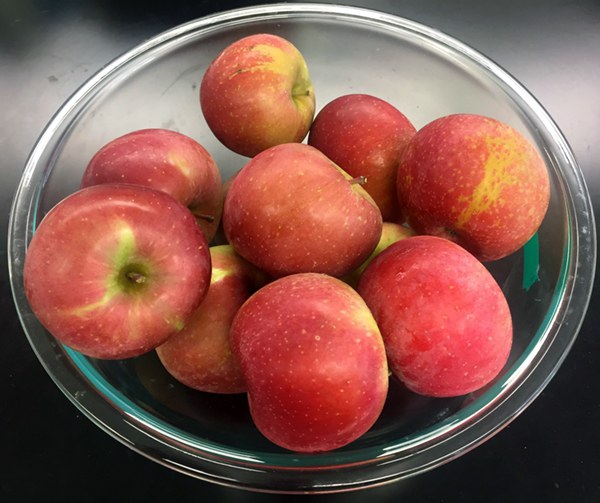This week we sampled Aztec Fuji, Cripps Pink (Pink Lady) and Granny Smith grown in Maryland.
Aztec Fuji fruit are tree-ripe while Granny Smith and Cripps Pink continue to mature very slowly. While Aztec Fuji fruit were tree ripe, their red color is not intense. Some fruit also had russet on the peel, likely caused by cool, wet weather after bloom.
Aztec Fuji
Spot picked Fuji fruit from a tall-spindle planting at Keedysville, Maryland had about 45 percent red color. While the fruit are not dropping, they have a Greenish Yellow ground color. Internal measurements of the fruit showed they had lost firmness to 14.7 pounds, with 15.8 degrees Brix and little starch remaining in their flesh (see photo). These Aztec Fuji fruit had some varietal flavor with mild water core developing around the vascular bundles in the flesh.
| Cultivar | Diameter (inches) | Red Color (%) | Ground Color | Firmness (pounds) | Soluble Solids (°Brix) | Starch Pattern (1-8 scale) |
|---|---|---|---|---|---|---|
| Aztec Fuji | ||||||
| Week 12 | 3.2 | 45 | Greenish Yellow | 14.7 | 15.8 | 6.5 |
| Cripps Pink | ||||||
| Week 10 | 3 | 31.8 | Light Green | 21.9 | 13.7 | 2 |
| Week 11 | 3 | 38.8 | Yellowish Green | 20.1 | 14.9 | 4.7 |
| Week 12 | 3.1 | 39.4 | Yellowish Green | 18.8 | 14.3 | 4.7 |
| Granny Smith | ||||||
| Week 10 | 3.2 | 0 | Green | 18.3 | 13.2 | 4 |
| Week 11 | 3.2 | 0 | Whitish Green | 18.3 | 13.5 | 4.9 |
| Week 12 | 3.3 | 0 | Whitish Green | 17 | 14 | 5.6 |
Granny Smith
The spot-picked Granny Smith apples were larger than the Cripps and are ready for long-term storage. Starch staining of these apples showed many fruit had lost starch in the core and also in the flesh (See the photo comparing starch patterns on Aztec Fuji, Cripps Pink, and Granny Smith).
During our weekly evaluations, we noted two disorders in Granny Smith fruit: sunburn and water core. Like many mid-Atlantic orchards, Keedysville received plenty of rainfall during the summer but almost none during September and October. While the shaded side of these fruit was still green, the sunny side of many Granny Smith apples was sunburned. This damage ranged from mild peel browning to severe pitting. For the third straight week sunburn was estimated to be 20 percent. In contrast to the mild water core noted in the Aztec Fuji fruit, water core in Granny Smith was deeper in the flesh and primarily in the sunburned fruit.
Cripps Pink
Cripps Pink fruit continues to slowly lose ground color and increase in red color. This is the first week Cripps fruit have shown their attractive pink color. While the red color of these spot-picked fruit was only about 40 percent, they are the most attractive fruit we evaluated this week.
The Cripps fruit have lost starch in their core region, and are losing starch in the flesh. While most apple varieties follow the Cornell starch chart nicely, Cripps - like Honeycrisp - patterns are a bit different from those shown in that chart. With their slow maturation, evaluating Cripps starch staining pattern has become easier, as riper fruit begin to resemble pictures on that chart.
Two weeks ago, we predicted Cripps harvest would be well ahead of schedule. Since then we've seen little change in their red color or internal fruit qualities. They are certainly ready for long-term storage but not ready to eat. This week's cooler weather should trigger Cripps ripening and lead to 'on-time' picking in early November.

Aztec Fuji, Cripps Pink and Granny Smith Apple Maturity. Starch staining pattern and red color development of Aztec Fuji (left), Granny Smith (center), and Cripps Pink (right) apples harvested from tall-spindle plantings at Keedysville, Maryland during the third week of October, 2017. Photo: Chris Walsh, University of Maryland


